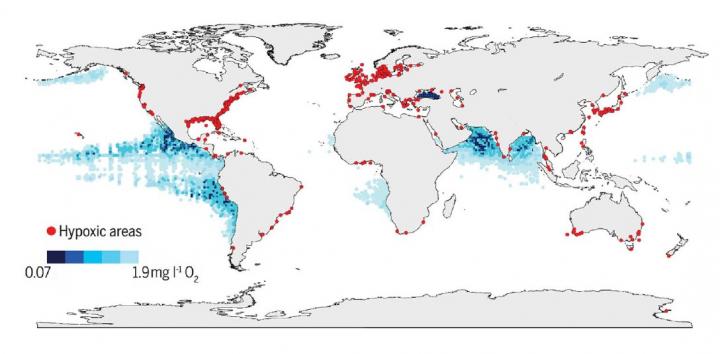
Credit: Figure courtesy of Breitburg, D., Levin, L.A., Oschlies, A., Grégoire, M., Chavez, F.P., Conley, D.J., Garçon, V., Gilbert, D., Gutiérrez, D., Isensee, K. and Jacinto, G.S., 2018. Declining oxygen in…
STONY BROOK, NY, April 23, 2020 – In a Policy Forum, “Dissolved oxygen and pH criteria leave fisheries at risk” published in the April 24 issue of the journal Science, Stony Brook University’s Dr. Christopher J. Gobler, Endowed Chair of Coastal Ecology and Conservation, and Stephen J. Tomasetti, Science Teaching and Research to Inform Decisions (STRIDE) fellow, consider accumulating scientific evidence on the harmful effects of coastal hypoxia (low oxygen) and acidification (decreasing pH, increasing acidity) in coastal ecosystems and suggest approaches that would address current policy shortfalls and facilitate improved protection of aquatic life.
During the past two decades, scientists have learned how hypoxia and acidification can act and interact to harm marine organisms. Hundreds of low oxygen or dead zones have been identified across the globe. Ocean acidification, a process resulting from the continued buildup of increasing atmospheric carbon dioxide in the oceans, has been discovered. And yet, regulation of dissolved oxygen (DO) and pH in coastal waters have remained unchanged.
The Clean Water Act aims to restore and protect the waters of the United States from impairment; waters that do not meet state standards are listed as impaired, a designation that can initiate critical remediation actions. According to Dr. Gobler, the current saltwater DO and pH criteria of many states allow for harmful conditions to persist without amelioration. “Our understanding of the dynamics of DO and pH and the effects on marine life have advanced dramatically this century to the point that it is now clear that criteria for pH and DO are likely to leave important marine species vulnerable to harm”, he said.
The reduction of DO and pH in coastal waters can individually have adverse effects on aquatic life, however, current regulations do not consider the combined effects of these stressors which are often experienced in combination and can be more severe than each stressor individually. Not until the scientific field of Ocean Acidification had been established, had their combined effects been broadly considered.
Environmental experts working to protect marine life see the need for better protection of coastal ecosystems. “Together ocean acidification and eutrophication are a double whammy, reinforcing each other – and increasingly harming marine and aquatic life.”, said Dr. Lisa Suatoni, Deputy Director of the Oceans Division at the Natural Resources Defense Council. She went on to state, “Tomasetti and Gobler cogently present an emerging truth: to address this combined impact, we need to reexamine our current regulations and the criteria we use to assess water quality.”
The Policy Forum suggests that by incorporating recent acidification-research into DO and pH policy, further improvements to coastal ecosystems are achievable. Many coastal states have established advisory groups consisting of researchers, stakeholders, and state officials to share information on the issue of coastal acidification. “We believe that continued collaboration between scientists, community members, and all levels of government can revitalize our coastal waters,” said Tomasetti. “Revising DO and pH criteria to reflect the latest science are important actions that will leverage the existing nationwide efforts to improve water quality and will help to produce and maintain the best possible outcomes.”
This study concludes with recommendations to improve the protection of coastal animals, suggesting revisions of existing water quality criteria, further scientific experiments, and additional pH-monitoring.
###
About Stony Brook University
Stony Brook University, widely regarded as a SUNY flagship, is going far beyond the expectations of today’s public universities. With more than 26,000 students, 2,700 faculty members, nearly 200,000 alumni, an academic medical center and 18 NCAA Division I athletic programs, it is one of only four University Center campuses in the State University of New York (SUNY) system. The University embraces its mission to provide comprehensive undergraduate, graduate, and professional education of the highest quality, and has been ranked among the top 35 public universities in the nation by U.S. News & World Report. Fostering a commitment to academic research and intellectual endeavors, Stony Brook’s membership in the Association of American Universities (AAU) places it among the top 65 research institutions in North America. The University’s distinguished faculty have earned esteemed awards such as the Nobel Prize, Pulitzer Prize, Indianapolis Prize for animal conservation, Abel Prize and the inaugural Breakthrough Prize in Mathematics. Part of the management team of Brookhaven National Laboratory of the U.S. Department of Energy, Stony Brook is one of only eight universities that has a role in running a national laboratory. Providing economic growth for neighboring communities and the wider geographic region, the University totals an impressive $7.23 billion in increased economic output on Long Island. Follow us on Facebook (https:/
Media Contact
Joan Behan-Duncan
[email protected]
Original Source
https:/
Related Journal Article
http://dx.




